Efficacy of Minimum Application of Chlorfluazuron Baiting to Control Urban Subterranean Termite Populations of Coptotermes gestroi (Wasmann) (Blattodea: Rhinotermitidae)
Simple Summary
Abstract
1. Introduction
2. Materials and Methods
2.1. Evaluation of the Effectiveness of Selective Baiting Using Chlorfluazuron to Control Termite Populations
2.1.1. Termite Identification
2.1.2. Study Site
2.1.3. Bait Station Preparation
2.1.4. Termite Feeding Consumption and Foraging Territory
2.1.5. Bait Placement
2.1.6. Data Analysis
3. Results
3.1. Evaluation of the Effectiveness of Selective Baiting Using Chlorfluazuron to Control Termite Populations
3.1.1. Bandar Baharu (BB)
3.1.2. CEMACS
3.1.3. Taman Rupawan (TR)
3.1.4. SMK Bertam Perdana (SMKBP)
3.1.5. SMK Tunku Puan Habsah
3.1.6. SMK Bukit Jambul
4. Discussion
5. Conclusions
Author Contributions
Funding
Acknowledgments
Conflicts of Interest
References
- Krishna, K.; Grimaldi, D.A.; Krishna, V.; Engel, M.S. 1. Introduction. In Treatise Isoptera World. Bull. Am. Mus. Nat. Hist. 2013, 1, 1–200. [Google Scholar] [CrossRef]
- Rust, M.K.; Su, N.Y. Managing social insects of urban importance. Annu. Rev. Entomol. 2012, 57, 355–375. [Google Scholar] [CrossRef] [PubMed]
- Kuswanto, E.; Ahmad, I.; Dungani, R. Threat of subterranean termites attack in the Asian countries and their control: A review. Asian J. Appl. Sci. 2015, 8, 227–239. [Google Scholar]
- Su, N.Y. Technological needs for sustainable termite management. Sociobiology 2011, 58, 229–239. [Google Scholar]
- Sajap, A.S. Serangga Perosak Pokok Ameniti; Jabatan Landskap Negara, Kementerian Perumahan dan Kerajaan Tempatan (in Malay): Buchang, Malaysia, 2009. [Google Scholar]
- Lee, C.C.; Neoh, K.; Lee, C.Y. Colony size affects the efficacy of bait containing chlorfluazuron against the fungus-growing termite Macrotermes gilvus (Blattodea: Termitidae). J. Econ. Entomol. 2014, 107, 2154–2162. [Google Scholar] [CrossRef] [PubMed]
- Scharf, M.E. Termites as targets and models for biotechnology. Annu. Rev. Entomol. 2015, 60, 77–102. [Google Scholar] [CrossRef]
- Broadbent, S. A stand-alone termite management technology in Australia. In Urban Pest Management: An Environmental Perspective; Dhang, P., Ed.; CABI: Wallingford, UK, 2011; pp. 145–155. [Google Scholar]
- Hajjar, N.P.; Casida, J.E. Structure-activity relationships of benzoyl phenyl urea as toxicants and chitin synthesis inhibitors in Oncopeltus Fasciatus. Pestic. Biochem. Physiol. 1979, 11, 33–45. [Google Scholar] [CrossRef]
- Yu, S.J. The Toxicology and Biochemistry of Insecticide; CRC: Boca Raton, FL, USA, 2008. [Google Scholar]
- Su, N.Y.; Ban, P.M.; Scheffrahn, R.H. Remedial baiting with hexaflumuron in above-ground stations to control structure-infesting populations of the Formosan subterranean termite (Isoptera: Rhinotermitidae). J. Econ. Entomol. 1997, 90, 809–817. [Google Scholar] [CrossRef]
- Tsunoda, K.; Matsuoka, H.; Yoshimura, T. Colony elimination of Reticulitermes speratus (Isoptera: Rhinotermitidae) by bait application and the effect on foraging territory. J. Econ. Entomol. 1998, 91, 1383–1386. [Google Scholar] [CrossRef]
- Peters, B.C.; Fitzgerald, C.J. Field evaluation of the bait toxicant chlorfluazuron in eliminating Coptotermes acinaciformis (Froggatt) (Isoptera: Rhinotermitidae). J. Econ. Entomol. 2003, 96, 1828–1831. [Google Scholar] [CrossRef]
- Carera, B.J.; Thoms, E.M. Versatility of baits containing noviflumuron for control of a structural infestations of Formosan subterranean termites (Isoptera: Rhinotermitidae). Fla. Entomol. 2006, 89, 20–31. [Google Scholar] [CrossRef]
- Evans, T.A. Rapid elimination of field colonies of subterranean termites (Isoptera: Rhinotermitidae) using bistrifluron solid bait pellets. J. Econ. Entomol. 2010, 103, 423–432. [Google Scholar] [CrossRef] [PubMed]
- Haverty, M.I.; Tabuchi, R.L.; Vargo, E.L.; Cox, D.L.; Nelson, L.J.; Lewis, V.R. Response of Reticulitermes hesperus (Isoptera: Rhinotermitidae) colonies to baiting with lufenuron in northern California. J. Econ. Entomol. 2010, 103, 770–780. [Google Scholar] [CrossRef]
- Chouvenc, T.; Su, N.Y. Subterranean termites feeding on CSI baits for a short duration still results in colony elimination. J. Econ. Entomol. 2017, 110, 2534–2538. [Google Scholar] [CrossRef] [PubMed]
- Thapa, R.S. Termites of Sabah; Sabah Forest Record: Sabah, Malaysia, 1982; Volume 12. [Google Scholar]
- Tho, Y.P. Termites of Peninsular Malaysia; Forest Research Institute Malaysia: Kepong, Malaysia, 1992. [Google Scholar]
- Tamashiro, M.; Fujii, J.K.; Lai, P.Y. A simple method to observe, trap, and prepare large numbers of subterranean termites for laboratory and field experiments. Environ. Entomol. 1973, 2, 721–722. [Google Scholar] [CrossRef]
- Su, N.Y.; Ban, P.M.; Scheffrahn, R.H. Suppression of foraging populations of the Formosan subterranean termite (Isoptera: Rhinotermitidae) by field applications of a slow-acting toxicant bait. J. Econ. Entomol. 1991, 84, 1525–1531. [Google Scholar] [CrossRef]
- Ab Majid, A.H.; Ahmad, A.H. Define Colony Number of Subterranean Termites Coptotermes gestroi (Isoptera: Rhinotermitidae) in Selected Infested. Sains Malays. 2015, 44, 211–216. [Google Scholar] [CrossRef]
- Su, N.Y.; Scheffrahn, R.H. Foraging population and territory of the Formosan subterranean termite (Isoptera: Rhinotermitidae) in an urban environment. Sociobiology 1998, 14, 353–360. [Google Scholar]
- Garcia, C.M.; Giron, M.Y.; Broadbent, S.G. Termite baiting system: A new dimension of termite control in the Philippines. In Proceedings of the 38th Annual Meeting on International Research Group (Stockholm) on Wood Protection, Jackson Lake Lodge, WY, USA, 20–24 May 2007. [Google Scholar]
- Peters, B.C.; Broadbent, S.; Dhang, P. Evaluating a baiting system for management of termites in landscape and orchard trees in Australia, Hong Kong, Malaysia, and the Philippines. In Proceedings of the 6th International Conference on Urban Pests, Budapest, Hungary, 13–16 July 2008; pp. 379–383. [Google Scholar]
- Lee, C.Y.; Yap, H.H.; Chong, N.L.; Jaal, Z. Urban Pest Control–A Malaysian Perspective; Vector Control Research Unit, Universiti Sains Malaysia: Penang, Malaysia, 1999. [Google Scholar]
- Sajap, A.S.; Amit, S.; Welker, J. Evaluation of hexaflumuron for controlling the subterranean termite Coptotermes curvignathus (Isoptera: Rhinotermitidae) in Malaysia. J. Econ. Entomol. 2000, 93, 429–433. [Google Scholar] [CrossRef]
- Lee, C.Y. Subterranean termite pests and their control in the urban environment in Malaysia. Sociobiology 2002, 40, 3–10. [Google Scholar]
- Lee, C.Y.; Vongkaluang, C.; Lenz, M. Challenges to subterranean termite management of multi-genera faunas in Southeast Asia and Australia. Sociobiology 2007, 50, 213–222. [Google Scholar]
- Peters, B.C.; Broadbent, S. Evaluating a termite interception and baiting system in Australia, Thailand and the Philippines. In Proceedings of the 5th International Conference on Urban Pests, Singapore, 11–13 July 2005; pp. 229–232. [Google Scholar]
- Su, N.Y.; Ban, P.M.; Scheffrahn, R.H. Control of subterranean termites (Isoptera: Rhinotermitidae) using commercial prototype aboveground stations and hexaflumuron baits. Sociobiology 2001, 37, 111–120. [Google Scholar]
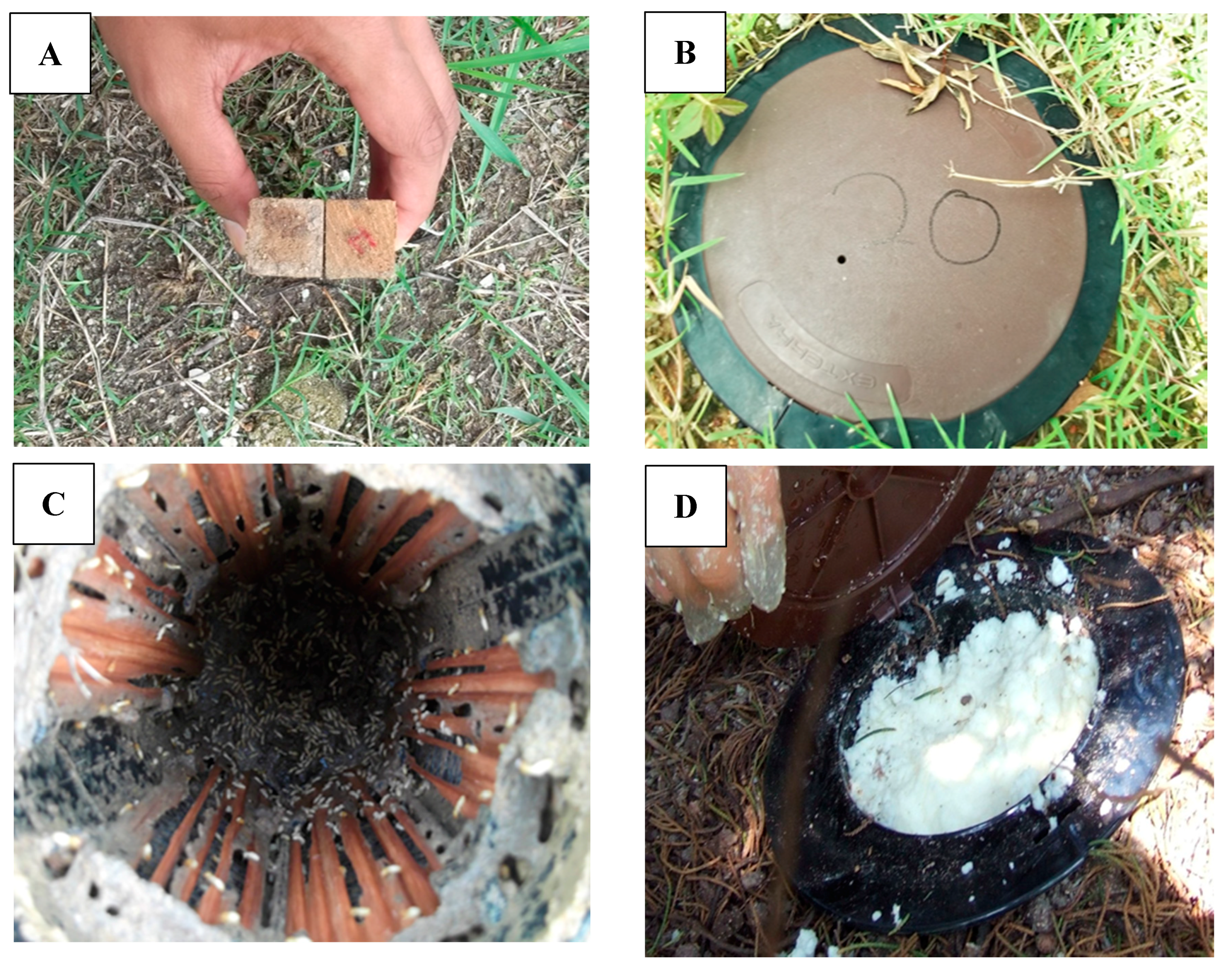
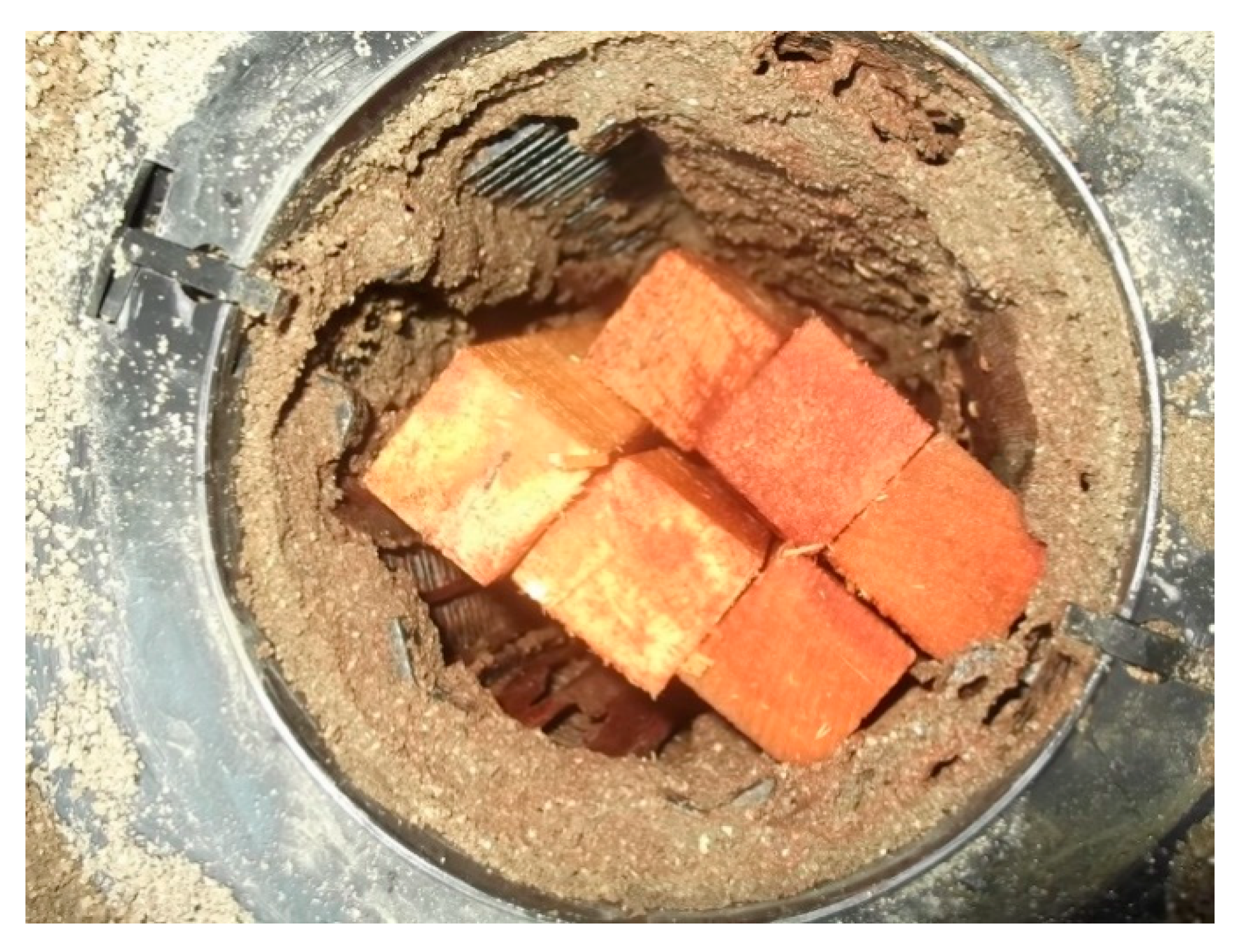
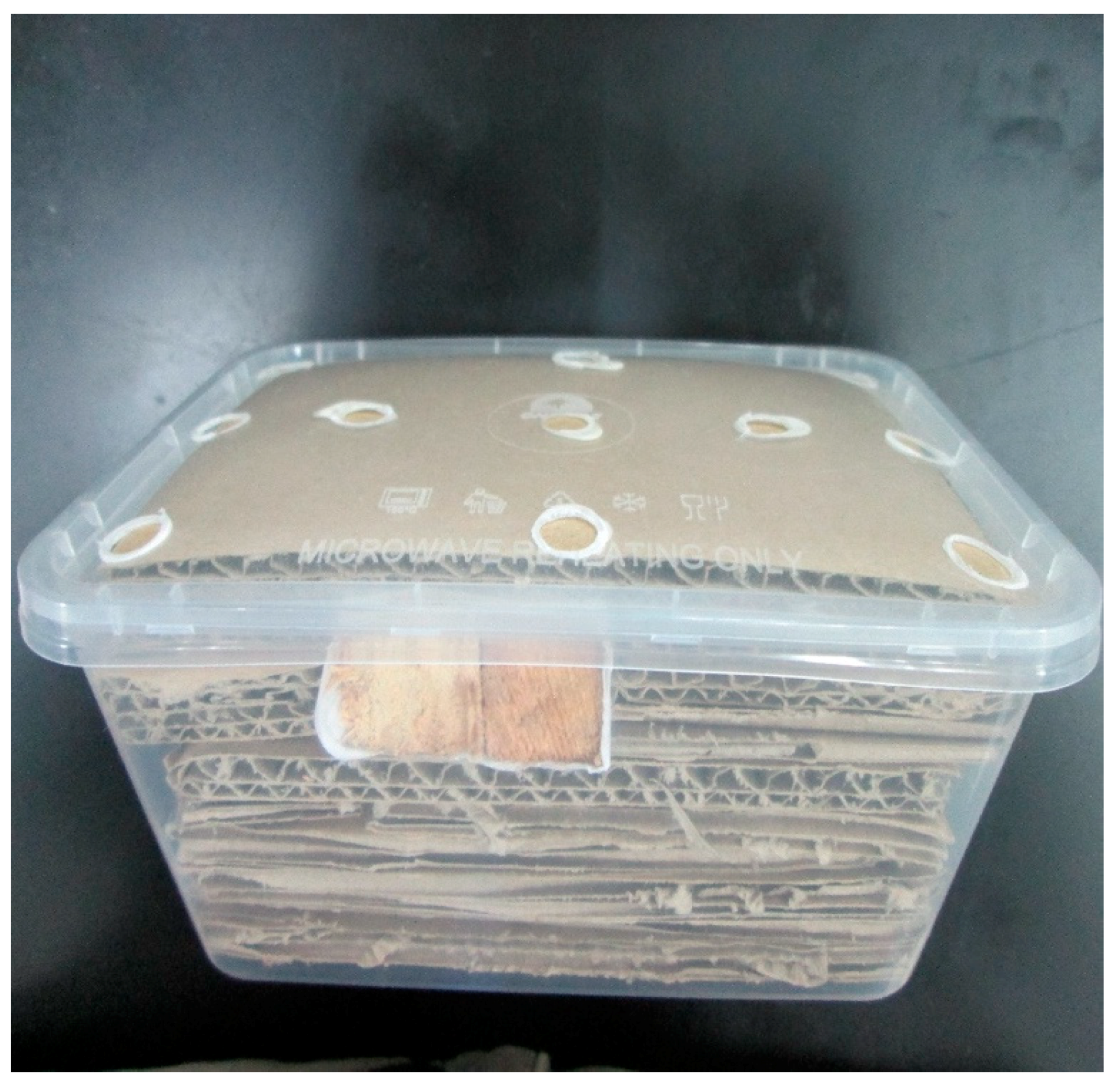
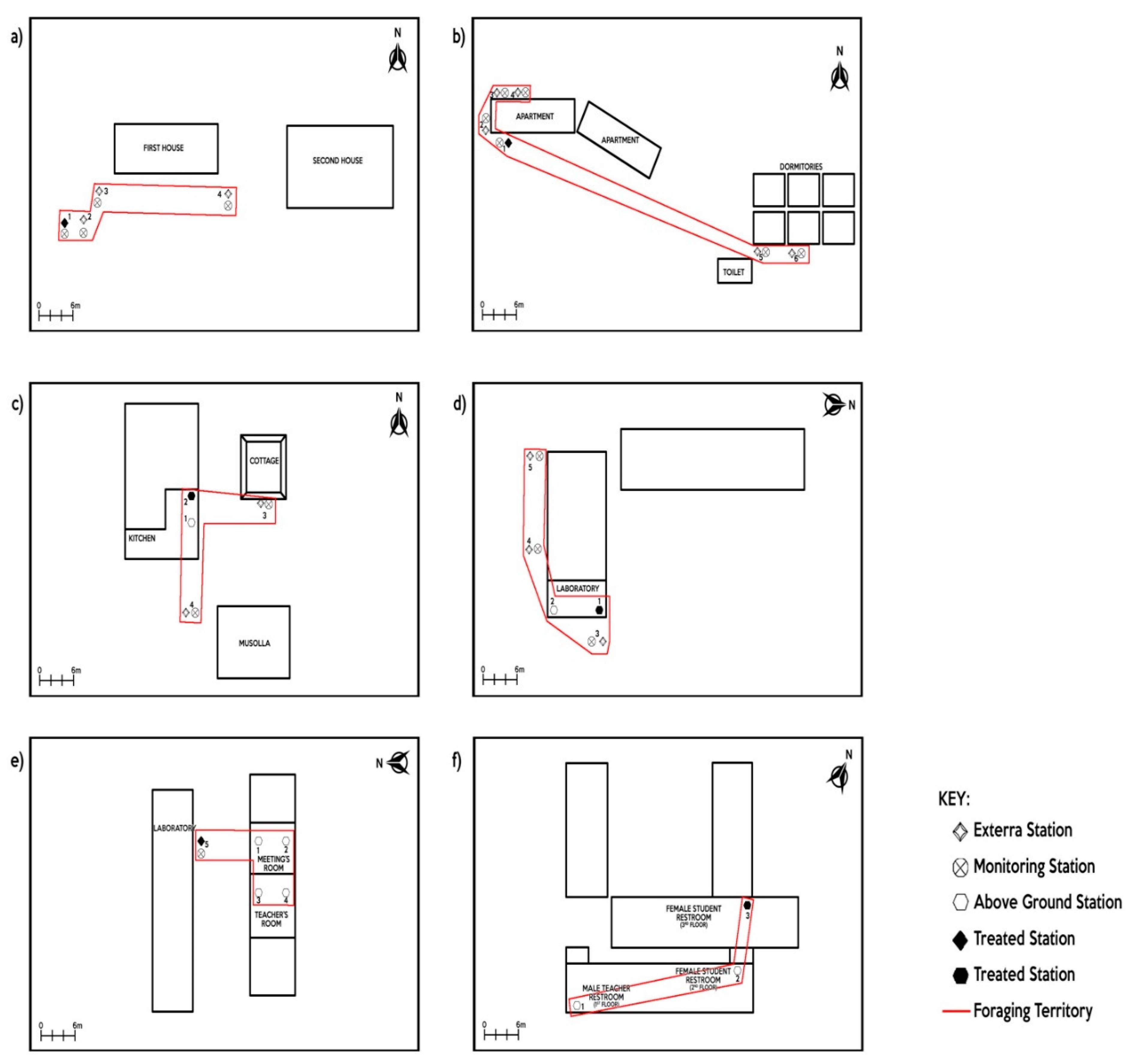
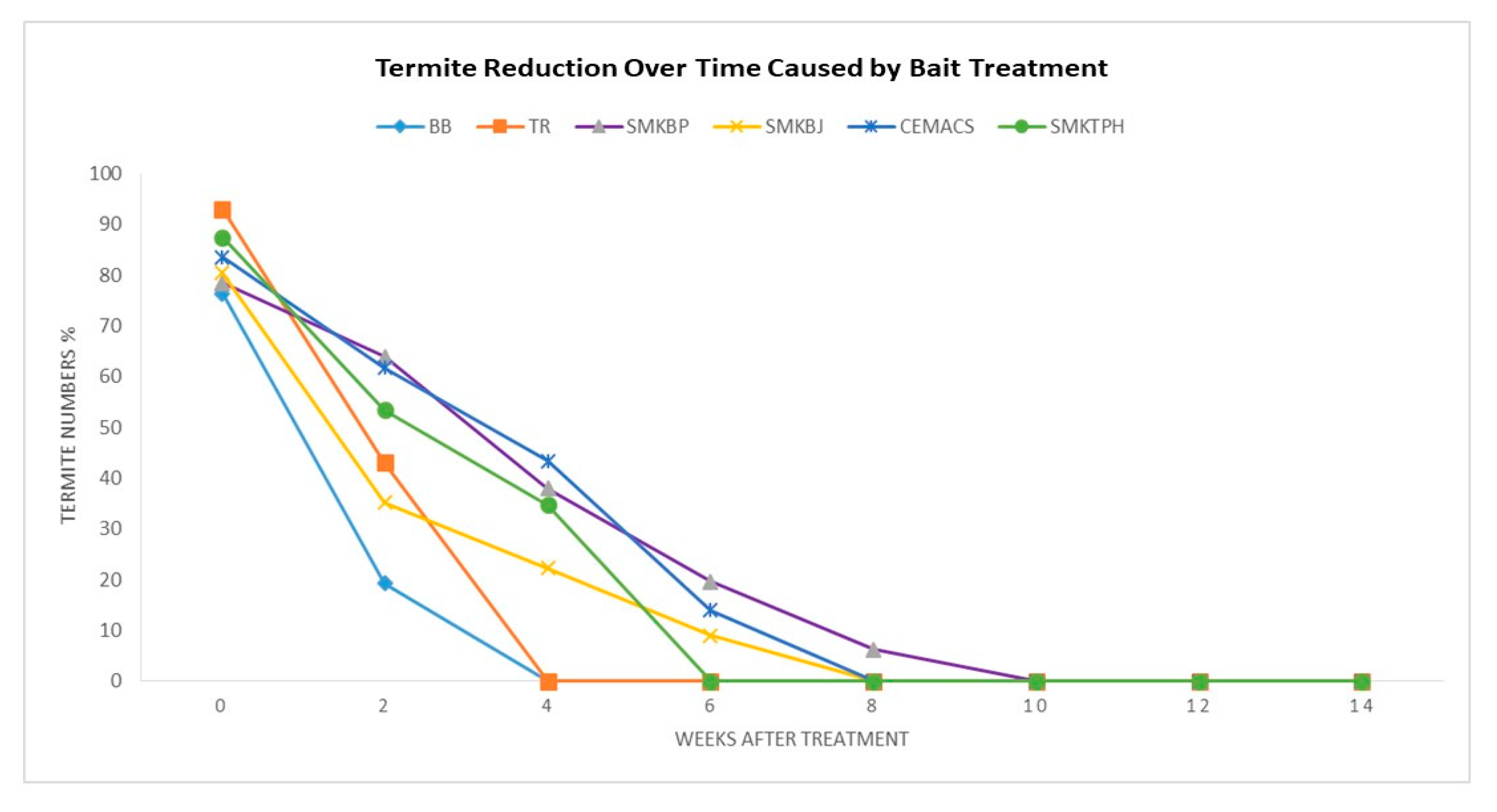
| State | Sites | Latitude | Longitude |
|---|---|---|---|
| Kedah | Bandar Baharu (BB) | 5°06′26″ N | 100°32′30″ E |
| Penang | CEMACS | 5°28′01″ N | 100°12′00″ E |
| Taman Rupawan (TR) | 5°30′25″ N | 100°26′34″ E | |
| SMK Bertam Perdana (SMKBP) | 5°31′50″ N | 100°27′59″ E | |
| SMK Tunku Puan Habsah (SMKTPH) | 5°25′15″ N | 100°18′27″ E | |
| SMK Bukit Jambul (SMKBJ) | 5°20′54″ N | 100°17′27″ E |
| Sites | Number of Active Stations | Number of Above-Ground Stations (AGS) | Number of In-Ground Stations (IGS) | Number of Stations Baited |
|---|---|---|---|---|
| Bandar Baharu (BB) | 4 | 0 | 4 | 1 |
| CEMACS | 6 | 0 | 6 | 1 |
| Taman Rupawan (TP) | 4 | 2 | 2 | 1 |
| SMK Bertam Perdana (SMKBP) | 5 | 2 | 3 | 1 |
| SMK Tuanku Puan Habsah (SMKTPH) | 5 | 4 | 1 | 1 |
| SMK Bukit Jambul (SMKBJ) | 3 | 3 | 0 | 1 |
| Sites | Total Number of Termites | Bait Consumed (g) | Time Taken for Colony Elimination (Weeks) | |
|---|---|---|---|---|
| Before | After | |||
| Bandar Baharu (BB) | 62.57 ± 16.48 | 15.94 ± 30.6 | 282.2 | 4 |
| CEMACS | 88.67 ± 1.71 | 33.78 ± 34.73 | 296.7 | 8.6 |
| Taman Rupawan (TR) | 82.35 ± 10.98 | 7.18 ± 17.58 | 278.6 | 4 |
| SMK Bertam Perdana (SMKBP) | 86.35 ± 2.84 | 36.13 ± 29.67 | 283.7 | 8.6 |
| SMK Tunku Puan Habsah (SMKTPH) | 90.80 ± 1.49 | 29.30 ± 36.28 | 216.4 | 6.3 |
| SMK Bukit Jambul (SMKBJ) | 90.34 ± 2.23 | 25.57 ± 29.68 | 278.4 | 8.6 |
© 2020 by the authors. Licensee MDPI, Basel, Switzerland. This article is an open access article distributed under the terms and conditions of the Creative Commons Attribution (CC BY) license (http://creativecommons.org/licenses/by/4.0/).
Share and Cite
Wan Umar, W.A.S.; Ab Majid, A.H. Efficacy of Minimum Application of Chlorfluazuron Baiting to Control Urban Subterranean Termite Populations of Coptotermes gestroi (Wasmann) (Blattodea: Rhinotermitidae). Insects 2020, 11, 569. https://doi.org/10.3390/insects11090569
Wan Umar WAS, Ab Majid AH. Efficacy of Minimum Application of Chlorfluazuron Baiting to Control Urban Subterranean Termite Populations of Coptotermes gestroi (Wasmann) (Blattodea: Rhinotermitidae). Insects. 2020; 11(9):569. https://doi.org/10.3390/insects11090569
Chicago/Turabian StyleWan Umar, Wan Ahmad Syahir, and Abdul Hafiz Ab Majid. 2020. "Efficacy of Minimum Application of Chlorfluazuron Baiting to Control Urban Subterranean Termite Populations of Coptotermes gestroi (Wasmann) (Blattodea: Rhinotermitidae)" Insects 11, no. 9: 569. https://doi.org/10.3390/insects11090569
APA StyleWan Umar, W. A. S., & Ab Majid, A. H. (2020). Efficacy of Minimum Application of Chlorfluazuron Baiting to Control Urban Subterranean Termite Populations of Coptotermes gestroi (Wasmann) (Blattodea: Rhinotermitidae). Insects, 11(9), 569. https://doi.org/10.3390/insects11090569






